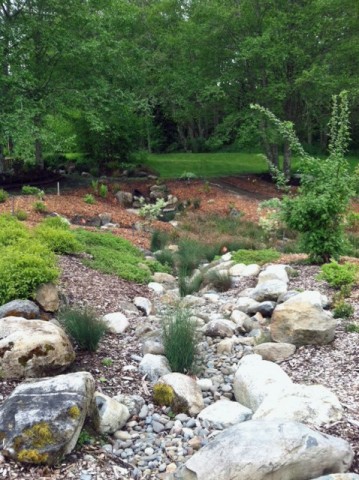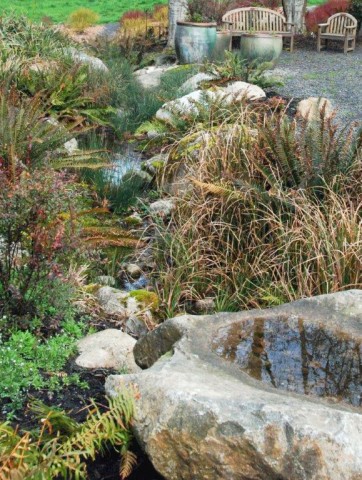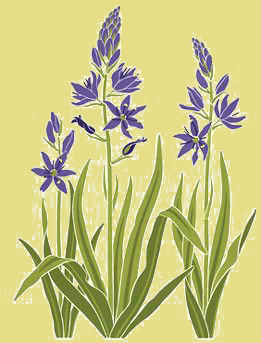Problem Solving with Dry and Seasonal Streambeds


Whether in a suburban or rural setting, when land is graded for home construction and impervious surfaces, such as roofs, paved driveways and patios are installed, the natural movement of water across the building site can be altered. This often results in areas of soil erosion or poor drainage, that are impediments to both vehicle and foot traffic and can turn into a landscaping nightmare.
One solution that can turn this kind of a problem into an attractive garden feature is the installation of a seasonal streambed, sometimes called a dry streambed. In dry weather, its rocks and plantings add interest to the garden, but in wet weather it becomes much more than just a design element. By funneling rainwater run-off into cisterns, curtain drains or storm drains or into more natural areas (bogs, rain gardens or ponds), it attractively solves drainage problems. In the Buck Lake Native Plant Garden, we have a seasonal streambed that effectively directs water run-off from an adjacent ball field into the basins of our rain garden, where plants filter the water before it enters nearby Buck Lake.
When planning your streambed, you first need to figure out where the water you want to direct is coming from and where you want it to end up. Position your streambed accordingly. Remember, this is a streambed, not a ditch. It should be a shallow swale (think about at least a 2:1 ratio, width to height), with sloping sides and should curve gently. Not only does a meandering streambed look more natural, it also slows down the run-off water. Line the streambed with large gravel and randomly placed rocks in a variety of sizes. To make the installation as natural looking as possible, use rocks that are indigenous to your area. If your streambed will carry a lot of water at certain times, avoid the use of pea gravel, which can easily be washed downstream.
Evaluate the plants you place along your streambed carefully. Choose only those that look naturally at home along a stream. Even if you do not garden exclusively with native plants, here is one place they could be used most effectively to add authenticity to your streambed installation. Consider repeating some of the same small trees or shrubs along the length of the stream - staggering them from one side to the other. Plants that have a weeping form are ideal for softening the edges of the stream. Underplant shrubs and trees with ferns, sedges and rushes and allow moss to grow in shady areas.
Many DIY websites will encourage you to put down landscape fabric as a weed barrier when you do your streambed installation, including the article we have linked to below. We did not used landscape fabric in the Buck Lake Native Plant Garden seasonal streambed installation. There are pros and cons to its use. The primary reason we did not use it is that, while it may help to cut back on weeds for the first year or so, eventually any mulch you put over the fabric to hide it will break down and create a medium for weeds to grow on top of the fabric. The same thing holds true for dirt that will blow in and settle among your gravel and rocks. The roots of weeds growing on top of the fabric can grow down through it and are even harder to remove. Another reason not to use landscape fabric is that it is difficult to change the design of your streambed, should it not work as intended or you merely want to make aesthetic changes. Removing plants that have been planted through holes cut in the landscape fabric is not easy. After they are planted, their roots spread out underneath the fabric and it can necessitate moving gravel and rocks and cutting large holes in the fabric in order to remove them.
The links below will take you to more articles about dry/seasonal streambed installation.

